Over the past decade, as we’ve watched social media transform before our very eyes, brands are increasingly recognizing the power of a strong organic marketing strategy — particularly moving towards a cookieless future. With brands facing unprecedented scrutiny in regard to authenticity, ethical practices, sustainability, inclusivity, internal culture, messaging, and wellness (to name a few), an organic marketing strategy is becoming the main focal point for many companies — which poses a unique set of challenges as brands battle for the attention, and trust, of their audiences.
Each organic marketing strategy for community-led growth is not necessarily a one-size-fits-all approach, as much as it is an exercise in ensuring that you understand the value your product offers, the audience that will recognize that value, and the way in which they interact and communicate with the brand and the brand with them.
While the process of building an organic marketing strategy for community-led growth may be less instantaneous than, let’s say, paid media campaigns, the yield is arguably greater and results in an extremely active and dedicated community if done properly — converting an organic community into brand advocates rather than passive customers.
This requires conducting extensive research (known as horizon scanning, or discovery) to better understand who already exists in the space you’re looking to occupy, what it is they’re doing, how you’ll be approaching the process differently, how you’ll get there, and ultimately what will happen after.
Let’s break it down.
Organic Marketing Strategy | Horizon Scanning:
Understanding your audience is quite possibly the most important factor in your success in building an organic marketing strategy for community-led growth — after all, authenticity is key and information is the largest component to not only understanding culture but leveraging it authentically.
The main components most brands will research while conducting a horizon scan are:
- Competitor Aesthetic
- Competitor Voice + Tone
- Competitor Product
- Social Landscape
By observing competitors in the space, as well as getting a broad understanding of the landscape at large, you’ll be able to better make decisions about how you build your brand and do so with purpose — whether that means the adoption of existing practices, or doing something completely different to set yourself apart and stand out.
Let’s Talk About Aesthetics in Organic Marketing Strategies:
The aesthetics of a brand covers a fairly broad spectrum of qualities and can be represented by anything from the color palette, to packaging materials, use of organic shapes, matte vs. glossy finishes on marketing materials, embossing on brand experience pieces, fonts, etc.
For the sake of simplicity, we’ll focus on color since it’s foundational to every brand and easiest to understand in the simplest terms — though a comprehensive horizon scan will take all of these factors into consideration while making choices for the brand as they relate to the aesthetic relationship to the organic community and those specific communities visual preferences and biases.
Colors are a huge factor in building a brand that is recognizable and accumulating strong brand recognition and recall — you want people to see a particular color or palette, and immediately be able to associate that visual cue with your brand. If we were to look at three of the most iconic brands ever created (not to say we’re loving them necessarily, but it’s undeniable that they are world-renowned and instantly recognizable) Wendy’s, Burger King, and McDonald’s have nearly identical color stories (In N Out, Chick-Fil-A, and Five Guys all also use similar colors but are arguably less iconic), and yet they are easily distinguishable from one another due to the hierarchy of their color stories and subtle nuances in tones, hues, and saturation.

As a thought exercise, if we were looking to build a fast-food chain, we would have two possible directions that our horizon scan would point us in.
- Use a Red + Yellow color palette because the top 3 major competitors use that variation of color.
- Use Blue + Green or another set of opposing colors to set yourself apart from the major brands in the space and stand out.
If we were to look at a major disruptor in the fast-food industry, Shake Shack, which was founded in 2001, entered the scene with its now instantly recognizable Green + Black color palette. While this may seem like an insignificant choice, it has allowed them to accomplish a number of things in their efforts to build an organic marketing strategy, focused on community-led growth around the brand:
- It doesn’t blend in with the legacy burger chains that all share a very similar palette.
- It reinforces their message that they are a burger chain that isn’t like the others in the field.
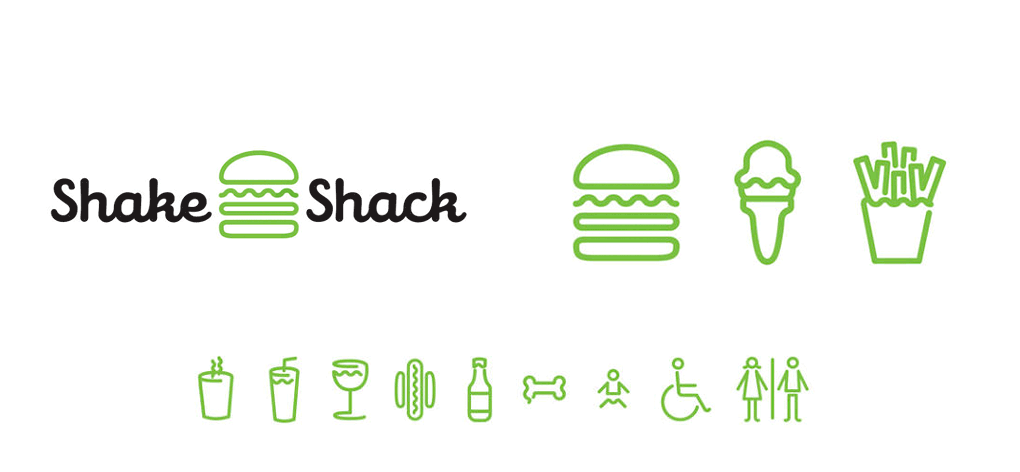
Circling back to the topic of authenticity, their product reinforces the story that they tell with their branding — something that would be ineffective if they didn’t provide a level of quality that stands apart from their competition. It’s because of this that they have developed such a strong and enthusiastic organic community, which can often be found waiting in lines that stretch for blocks just to grab a burger — something their competition certainly cannot claim for themselves.
Let’s Talk About Voice + Tone for Your Organic Marketing Strategy:
Code-switching is possibly the most useful tool for any great copywriter or brand developer. So much of the process of building trust in an organic community is being able to effectively understand and replicate the language of that community in order to not signal any red flags in your messaging or otherwise label yourself as an outsider — after all our goal is to integrate ourselves into the community, not alienate ourselves from it.
A great example of this, without getting too granular, is the phenomenon of the “OK Boomer” meme — a term coined by Gen-Z and Millenials to address more mature generations who “don’t get it” or are otherwise out of touch.
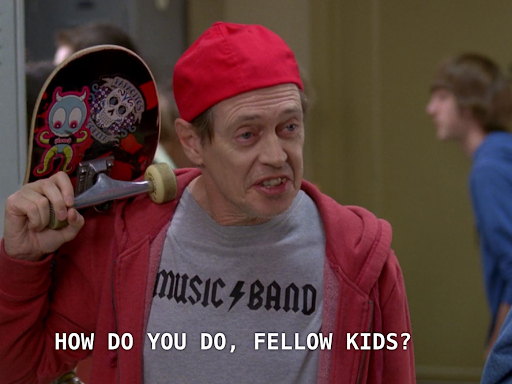
This elegantly illustrates the importance of voice + tone in our development of organic marketing strategy as the vernacular and deployment of that vernacular are key indicators of ‘belonging’ and misuse of particular terms or phrases can easily cause an immediate lack of trust with an entire community of people.
As the antithesis of this, as illustrated by Stephen Colbert, these mechanisms can also be used to build organic community through a shared lack of understanding. This can be seen frequently in certain landscapes, such as cryptocurrency, where not knowing about something, or understanding the lingo, can be a unifying force or keystone in the identity of your brand’s tone + voice.

Ultimately, by studying the language of the existing organic community you’re looking to adopt, or you’re looking to have adopt your product, you can better understand how to shape your messaging. By learning their language, you can make considerations for whether or not there are particular slang terms that are unique to your audience, and avoid possible pitfalls like misappropriating the term “cheugy” in your copy.
Let’s Talk About Product in Your Organic Marketing Strategy:
Product driven community builds can be highly effective if you’re conducting your horizon scan alongside your development process — since it’s likely new insights will be unearthed as you interact with different communities on social media, conduct research, test competitor products, and generally become more familiar with the landscape as a whole.
Depending on what type of product you’re building, the approach here can vary significantly. For example, researching competitors for a piece of software can be as simple as reading reviews on their website, on the iOS app store, interacting with communities on product dedicated subreddits, and even just downloading their apps internally and seeing what they’ve done, what you’d like to do differently, and what the main sources of criticism are in the reviews and comments across various platforms.
Taking these processes a step further as a mechanism for the community-led growth as a part of your organic marketing strategy, these interactions can be leveraged as a means of organic outreach to let the organic community know that:
A) You hear them.
B) You’re working on a solution.
In terms of software, this can be helpful in converting early adopters to your product, as well as developing a loyal base of individuals who will advocate for your product and even assist with testing it.
For physical products, there are similar practices in place as a means to understand your audience and help to optimize the development of your product.
Focus groups, as antiquated as it feels typing that, can be helpful in receiving unbiased feedback from real people who can experience the product journey of competitive products in the field and provide actionable feedback.
Ultimately, the goal of this process is to experience what exists already in your product category, interact with the communities that exist around those products, hear and understand their pain points, and leverage that feedback to build trust in your project while making improvements.
Social Landscape:
Digital landscapes are totally a thing, and they are an incredibly important aspect of your horizon scan – because even the most finely tuned brand, with perfect messaging, and immaculate delivery, will mean nothing if your audience is in a different location.
To think of this in IRL terms, if you’re starting a dodgeball league, a great place to put flyers would be your local gym, the YMCA, or similar community hub where those interested in physical activities might see it — you wouldn’t necessarily want to distribute them at a retirement home, those are reserved for pickleball.
The same can be said for the internet, and understanding which platforms are best for which purposes can be highly beneficial to building a successful organic marketing strategy, as well as knowing where existing communities are “hanging out.”
Here’s a quick little breakdown of the top social platforms, their (very) general demographics, and use cases:
TikTok:
The platform of authenticity — TikTok is the platform of choice for Generation Zed (and Millenials too).
With a focus on celebrating the individual in a very “come as you are” way, the platform thrives off of not only being yourself but being a part of a global community. With an algorithm that is finely tuned to virality, with metrics focused more on views and likes than followers in many cases, trending sounds give opportunities for individuals to be a part of a larger conversation while experimenting with their contributions in order to craft them to cater directly to their audiences.
Though the platform has been around since 2016, it is still very much figuring out its identity, and many new entrants are finding ways to carve their own niches into the platform — with dedicated communities like #cryptok finding a way to leverage the platform as a means of educating their audiences rather than simply following trends and sounds.
Due to the iterative nature of the platform, TikTok provides an incredible space for experimentation and learning as communities form around projects. During the course of 24 hours, a post can go viral and accumulate millions of likes and views to provide valuable insights and impressions within the community which you can then leverage across other channels and create optimizations for in your strategy.
As with all channels, messaging must be carefully crafted to cater specifically to the culture that is TikTok to ensure that trust isn’t broken with the audiences there. Creating content that is too product-driven, or feels too much like a traditional ad, can be counterproductive and cause audiences to lose faith.
This isn’t to say that promoting products is completely off-limits. Product-driven content on TikTok should be more demonstrative in showing the benefits of the product itself rather than simply informing the community about what the product is — showing how something works, or what the results are will get you much farther than simply telling the community what it does. And as an extension of this, educational content is equally as welcome as audiences will feel more comfortable supporting a product or service if they feel as though they have a fundamental understanding of not only the product, but how it’s made, and whether or not the messaging is authentic.
Twitter:
The short-form text platform, in recent history, has been starting to go long-form — with Twitter threads turning the epicenter for internet-hot-takes into a destination for comprehensive overviews, how-tos, and case studies. Gone are the days of the platform serving simply as a means to make snarky comments to celebrities, and here has arrived the new era of Twitter as a hub for information.
Aside from flexing your brain muscles in order to share expert insights into the field or product you’re looking to break into, Twitter conversations are a fantastic means of developing an audience and creating organic community.
Nothing particularly revolutionary about the practices in place here, aside from the urgency which exists for certain conversations to be had. As we’ve recently witnessed with Elon Musk setting Twitter ablaze, many leveraged the conversations happening in real-time to chime in, share their perspective, and engage in conversations happening throughout relevant communities to help magnify their perspective and encourage others to join their own communities.
A well-placed response to a Twitter thread can significantly boost interactions and reach for your brand, establish thought leadership, or simply align your brand with a certain perspective within the community you’re seeking to build upon.
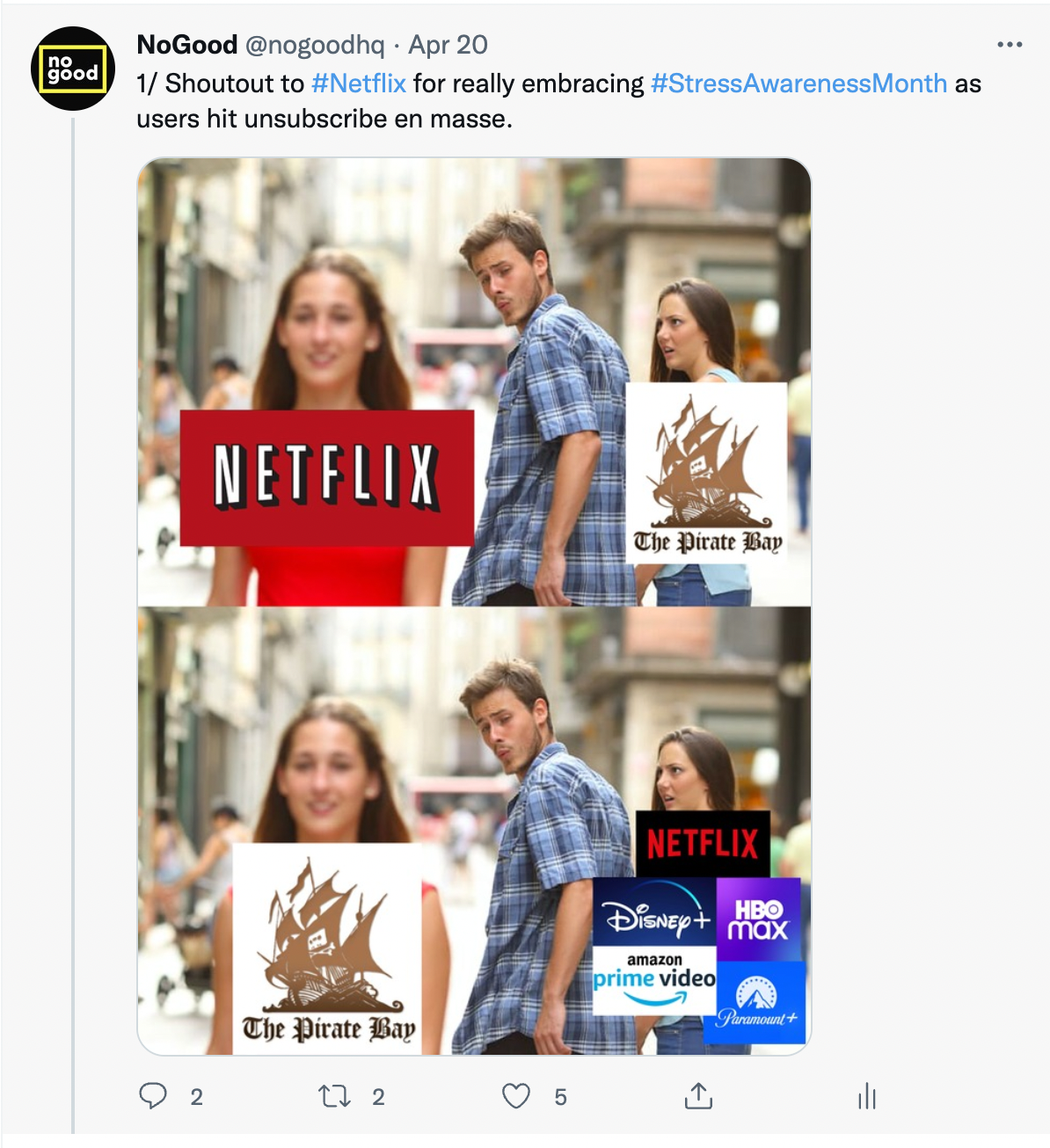
Social listening tools such as Sprout, Feedly, or RSS, can be immensely helpful in tracking conversations in real-time, gauging community sentiment towards certain topics, and recognizing trends to capitalize on as they develop. Success on Twitter is very much time-sensitive in the early stages of your community development, so dedicating time to ensure you’re monitoring the right hashtags and accounts, and being where the conversations are happening, when they’re happening, will be the greatest key to your success.
Instagram:
The OG visual sharing platform, Instagram is still the premier destination for users aged 25-34, which is still seeing steady growth year over year despite its super-lean team of under 500 people.
With a recent return to the chronological scroll that made the platform a household staple back in 2010, Instagram offers a great opportunity for discovery for those willing to do a bit of hashtag research and manual outreach and engagement as a part of their organic marketing strategy.
The platform has also been nipping at the heels of TikTok with the introduction of Reels in August of 2020 — more or less copying the homework of the seemingly unstoppable juggernaut that has taken the Gen Z demographic by storm.
Despite attempts to compete with TikTok, Instagram has retained its legacy of being a platform for pretty things and finds its own authenticity in maintaining its reign as the only place for sharing things “Instagram worthy” (read: really pretty) — with TikTok users preferring a more authentic approach to content (more on this later).
This makes Instagram a natural choice for any aesthetic-driven brand, particularly in graphic design, branding, interior design, and beauty spaces — through brands in the fintech and crypto space are actively finding success in making learning about their products a visual experience.
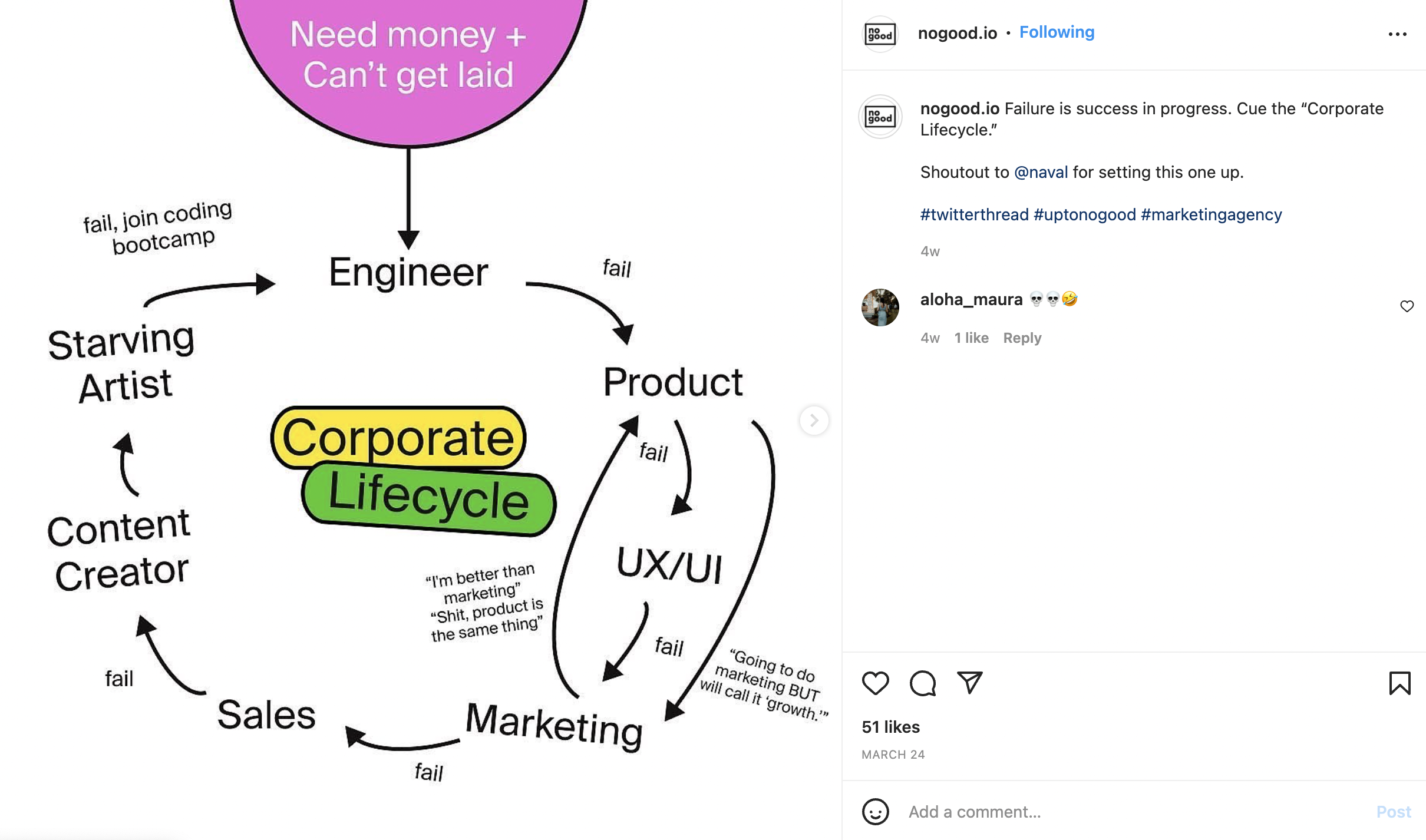
Also worth noting is that, while chronological scrolling has made a return, this is likely due in part to the fact that the Instagram algorithm (or digital deities as we like to call them) heavily favors those users sharing Reels and Stories — so your organic marketing strategy may be somewhat limited depending upon your audience and how they interact with the space if you were only posting still images. There is also heavy encouragement for brands to leverage paid media for their channels, and while there’s no quantifiable evidence, it is widely accepted that business accounts have their engagement throttled by the digital Instagram deities as a means for the Meta parented platform to encourage brands to spend their ad dollars for growth.
As a general best practice, it’s recommended to begin building your brand presence without the additional features provided for business accounts if at all possible during the early stages of your business. The algorithm will initially boost your performance as a non-business account to encourage further interactions on the platform, rather than throttling it to encourage ad spending. You can then make the move to a business account once an audience is established and actively engaged to the point where it’s worth leveraging having a shoppable account and access to the other features for businesses that Instagram offers.
A tried and trusted flow for audience development has been to launch an Instagram organic marketing strategy 3-6 months prior to the launch of your business to gauge community interest, perform organic outreach and engagement, and tease out your product to the public pre-launch. This not only capitalizes on the early stages of boosted traffic from the algorithm for the new account but does so without sacrificing potential sales during the period before product is available.
Messaging during this period can be geared towards education on your particular product or vertical, while also presenting organic community driven content to receive actionable feedback from the community as product is being finalized and packaged for ship.
Facebook:
With a demographic that is 77% aged 30-49, Facebook is actually more popular among millennials than any individual millennial would ever admit to. While that is just a single data point to consider, it still tells us a lot about the type of audience that we could potentially reach there.
While Facebook pages may not be too heavily utilized as a means of building community — Groups have become the latest craze in the community building architecture on the platform.
Into cycling? There’s a group for that. Baking? There’s a group for that. Crochet? There’s a group for that. Crypto? There’s probably at least a million groups for that at this point.
The beauty of Facebook groups is that they provide a qualified segment for organic interactions. When building organic content strategies, the biggest obstacle is testing hypotheses, measuring data, and then adjusting your deployment accordingly in order to reach your preferred audience — while these groups have already verified that these individuals are actively engaged in whatever segment it is that you’re aiming to break into.
Reddit:
Reddit, or ‘The Front Page of the Internet’ as they’ll call themselves, is a website dedicated to messaging boards for any topic you could possibly imagine, and even those you couldn’t. The site thrives off of community-driven content, and so is a wonderful place to interact with those dedicated to your cause, similar to the previously mentioned Facebook groups, or even building your own community around your product.
Primarily composed of users aged 19-29, the website skews to a younger male audience, though this isn’t to say that there’s no opportunity outside of this demographic. The site boasts 52M daily active users, with 130K active communities that are comprised of 2.8M subreddits — there’s literally a subreddit for everything.
From meme subs like /r/superbowl, which is dedicated to images of owls rather than the pinnacle of American sports events, to /r/eyebleach, a sub specifically for sharing photos of cute animals to cleanse your ocular palette whenever you’ve had a bit too much internet for one day, if a sub for your particular audience doesn’t exist, you can build one yourself.

Brands can leverage a dedicated subreddit to engage with their communities and audiences in a meaningful and impactful way, as users on the site will often search to see if a subreddit exists for a particular brand or product as part of their own discovery journey. This is a great opportunity to funnel an audience into a dedicated space where you can then share insights, learnings, wins, and other brand-driven metrics directly with your pre-qualified community.
Similarly, Reddit as a channel for customer service is a proven approach to leveraging the platform to build community and plus-up customers into advocates. Verizon, which has achieved notoriety for having…less than stellar customer service practices, with users complaining frequently about long wait times while utilizing the chat platform on their website, has turned their unofficial subreddit into a unique, and remarkable customer service experience.
Official reps from the company will often post comprehensive guides to their quarterly promotions with breakdowns of the promotions, how to qualify for them, along with tables and charts outlining just exactly what to expect if you’re applying for one of the promo deals, while also actively engaging with those asking questions in the comments and doing a decent amount of hand-holding to ensure that anyone who is looking to capitalize on one of their deals can do so.
This is a fantastic illustration of not only how to properly build community on Reddit, but how to do so in a way that is meaningful and valuable to your audience. Despite not owning /r/verizon, the reps interfacing with the community work with users on an individual level, breaking through Verizon’s corporate veneer, creating a meaningful and personalized experience which we’re now talking about — which one could argue is evidence that their efforts are working!
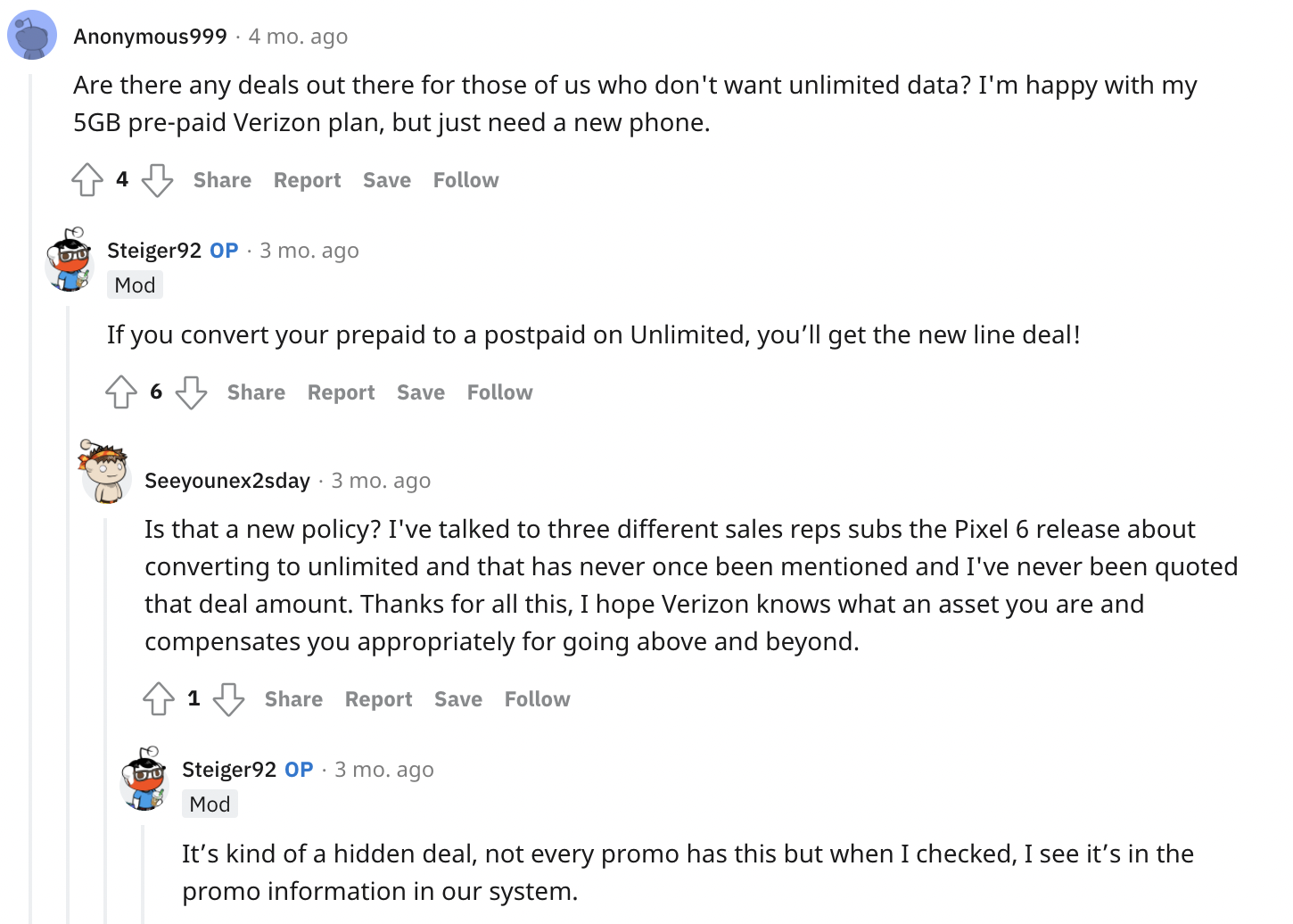
While this illustrates an effective approach to customer service on Reddit, it also brings to light the potential pitfalls of having a subreddit dedicated to your community that you’re unaware of — even if you’re not planning to implement Reddit as a part of your strategy, it’s important to do due diligence and regular scans to ensure that one doesn’t exist or popped up.
As mentioned, /r/verizon is an unofficial subreddit, meaning that Verizon itself isn’t the owner of the space — despite meaningfully interacting with it. The potential antithetical outcome of the unofficial subreddit existing is that it becomes a space for feedback and criticism, generating public negative sentiment, which can potentially fester and devolve into a terrible brand optics situation with users finding the subreddit, and reinforcing potentially negative experiences due to unchecked and unmitigated feedback loops.
Discord:
Originally adopted primarily by those in the gaming community for group chat functionality while in-game, Discord witnessed a fairly substantial growth period during the pandemic growing from 50M monthly active users in June 2020, to 150M by September 2021. As we collectively socially distanced ourselves, Discord proved as a versatile tool for consolidating friend groups and acting as a hub for social interaction with users hosting virtual movie nights, game nights, dance parties, concerts, and other forms of activities — all in a digital format. And while there isn’t a great deal of public data available on their demographic makeup, there is anecdotal evidence that their demographic has evolved to be more inclusive from their presumed roots of 30-something male gamers who were most utilizing the platform pre-pandemic.
Sharing much of the same DNA as Slack, Discord servers can be built for specific purposes (ie; growth marketing communities), with individual channels that are dedicated to a sub-genre or topic within that landscape.
For the early stages of building an organic marketing strategy, the practices remain fairly static as compared to other platforms — discovering where your audience hangs out, engaging with them, providing value, and encouraging adoption will be the keystone to successfully building your own community.
Similar to Facebook groups, and subreddits, brands are beginning to recognize the value potential of Discord as a means of building community within a dedicated space. This can be highly valuable for brands looking to build community as they can offer early adopters the opportunity to not only interact directly with the brand, but also empower them to help shape the future of the community by suggesting programming concepts, channel ideas, and reward systems, and other meaningful opportunities for engagement.
Discord can also be an incredible means for filtering feedback and criticism into a space that’s “dark” (ie; not indexed for search). Brands building communities on Discord can implement dedicated feedback and FAQ channels to which they can point all traffic as a means of preventing negative sentiment from finding its way onto more public spaces such as Reddit, Facebook, or other social media. This, however, is only effective if there’s meaningful attention given to the feedback and substantial efforts made to remedy the grievances being brought through the channel.
Leaning further into the “dark social” aspects of Discord, it has found a fairly substantial niche as a tool for those seeking to build communities in restricted verticals. As crypto, legal cannabis, and other forms of gray areas in the legal consumer product spaces navigate their relationships with traditional social platforms, many products and projects find themselves often being shadow-banned, or outright banned — often necessitating that they have backup accounts and back-ups to that back-up account.
As a reaction to this, many have begun, as a common practice, funneling their audiences to alternative channels, such as Discord, in order to maintain their audience in the event that they have their account banned.
Engagement Hierarchy:
Something to consider as you dive in and engage with these communities is the qualitative value that they possess. While social media is very much still a numbers game, the focus has shifted significantly in recent history to be more quality, less quantity.
This is an important distinction to make throughout the process of building your community, as the larger communities tend to be easiest to access, but lowest yield — as they’ll be inundated with chatter, and most likely stuffed with others looking to accomplish the same goal you are.
Smaller communities may seem as though they’re low yield due to their smaller headcount, but the qualifications and quality of those heads is significantly higher.
As an example, there is a Youtuber who uses the handle, “NakeyJakey” which has 1.7M subscribers to their Youtube channel, with content specific to music, video games, and pop culture. This same content creator has a dedicated Subreddit of 16.8K followers who are incredibly active, despite Jakey releasing content infrequently, if not entirely erratically.
Why does this matter?
Let’s say we’re building a new video game, and we’re conducting a horizon scan and want to engage with and leverage Jakeys audience because our hypothesis is that they would enjoy the game we’re building.
As we conduct our horizon scan and build our community, we see multiple paths through the hierarchy of Jakeys content that we can choose to engage in.
We can:
- Comment on Jakey’s Youtube videos promoting our product.
- Offer a review code for Jakey to feature our game in his content.
- Give away some free codes to the game on his subreddit.
This wasn’t necessarily a quiz, but the right answer is C.
As we observe the landscape, our initial impulse would be to engage in the channel that has the highest volume, which would be A since Jakey has 1.7M subscribers. The issue that arises here is that you’re now competing with 1.6999999999999999M other voices in the room for attention.
We could also choose to offer Jakey the code for our game, though he doesn’t post frequently so it’s unlikely that that avenue would happen with enough urgency to get the attention of the community that we seek.
However, giving away codes to his subreddit ensures that, despite it being a smaller sample size, we are interfacing directly with the most dedicated and active components of his community, and will likely experience a higher conversion rate as a result.
The same can be translated to most channels for social media, in that, while it’s incredibly entertaining to see Kloe Kardashian promoting migraine medication on Instagram, it’s fairly unlikely that that channel is primed for those conversations and conversions — though I hope she was able to help at least some people treat their migraines because they are not fun.
The takeaway here, similar to the case study of NakeyJakey, is that there exists a subreddit dedicated specifically to those who suffer from migraines with a community of 92k people who are actively engaged in the conversation about living with migraines and their various experiences with the different treatments available on the market.
If we do a shallow dive into the metrics, as one does, we’ll see that Nurtec’s Instagram page is hovering around 12.7k followers, meaning that even if Kloe Kardashian (who has 235M followers) was responsible for each and every single one of the followers currently represented on their page, the conversion rate would only be .005% (hint: that’s NoGood).
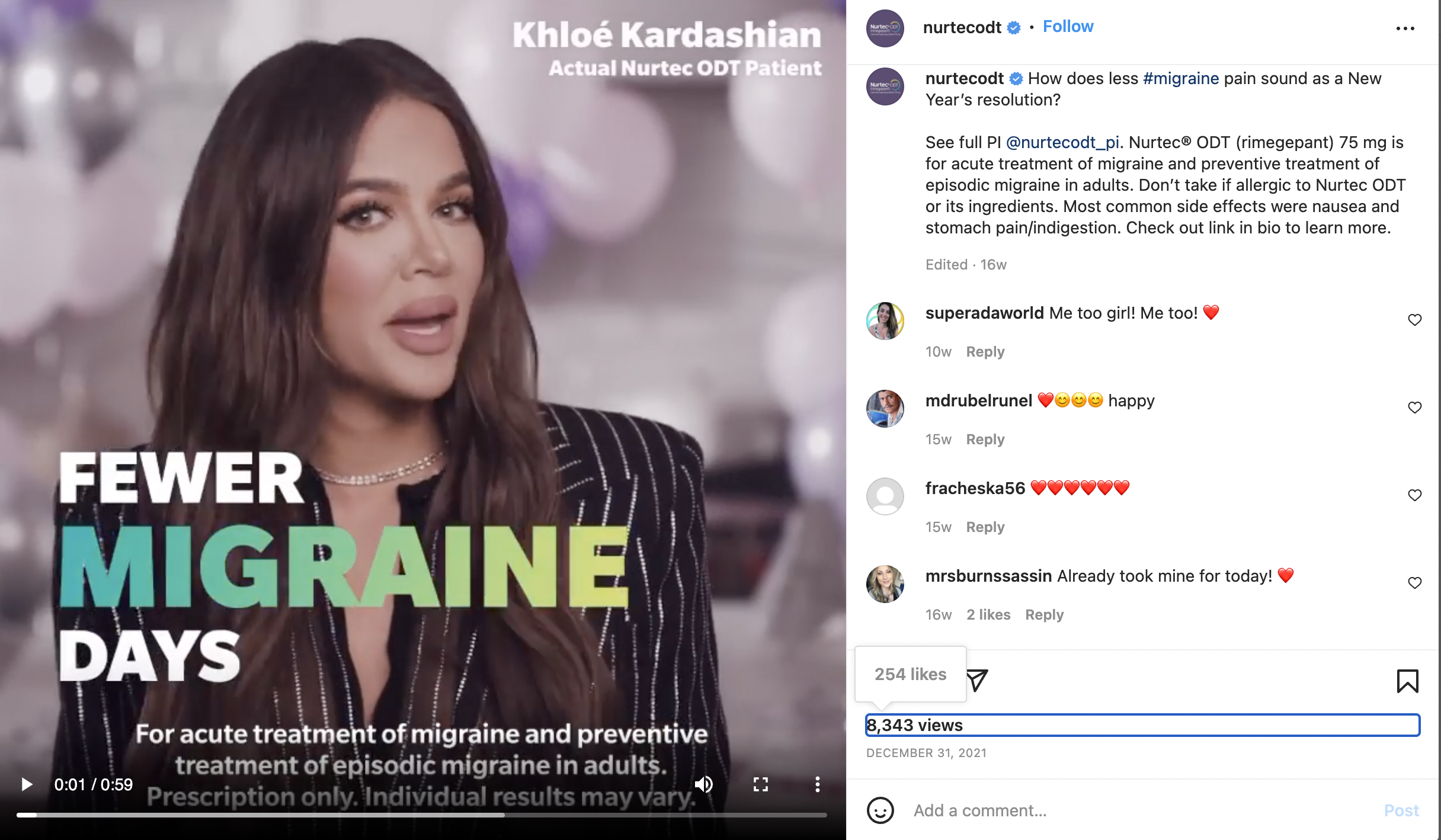
How does that sway our perspective on the migraine subreddit? Suddenly, those 92k people present substantially higher value from a community perspective than the 235M represented on Kloe’s Instagram page. Diving a bit deeper we can also see that the Instagram ad received no mentions in the subreddit, though there are a number of mentions of Nurtec by name, which poses an example of the previously mentioned opportunity for engagement for the brand to answer questions, or follow up with those sharing positive feedback.
Side-note: There’s a Nurtec subreddit that seems abandoned.
Bonus Tip: Abandoned social media channels are arguably worse than not having one at all.
Wrapping It Up:
Building community can be a fun, and exciting process, but there’s not necessarily a one-size-fits-all solution for success — as different demographics and groups with different interests tend to gravitate towards individual platforms that specifically serve their needs and interests.
As a result, it is important to load the front end of your community-building efforts with a substantial amount of research so that you are able to effectively identify who it is that you’re seeking to engage with, where it is that they’re located, and what it is that you can offer them as an incentive or value proposition for joining your community over, or in addition to, those communities that already exist.
When taking the leap from research to building, the intention is key. For every post you make, tweet you tweet, or poll you post, it’s important to consider what value you’re offering to your audience, and why they should interact with your content. Though we do tend to look at content and community through the lens of authenticity, it’s also important to recognize that each interaction we have on social media is transactional — with your audience exchanging their time for the value you’re presenting to them through your content.
Our best advice, do what you believe in, put out the content you would most like to see yourself, and engage in a way that you’d like to see other bands engage with you and you’ll likely do just fine. All things considered, communities are made of people, and people want to feel validated and seen — see them.





